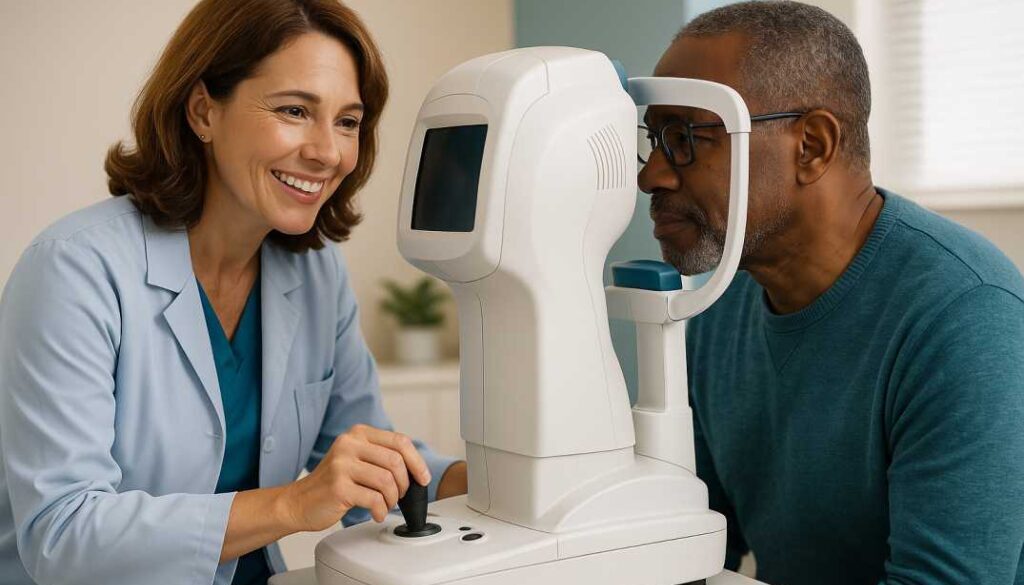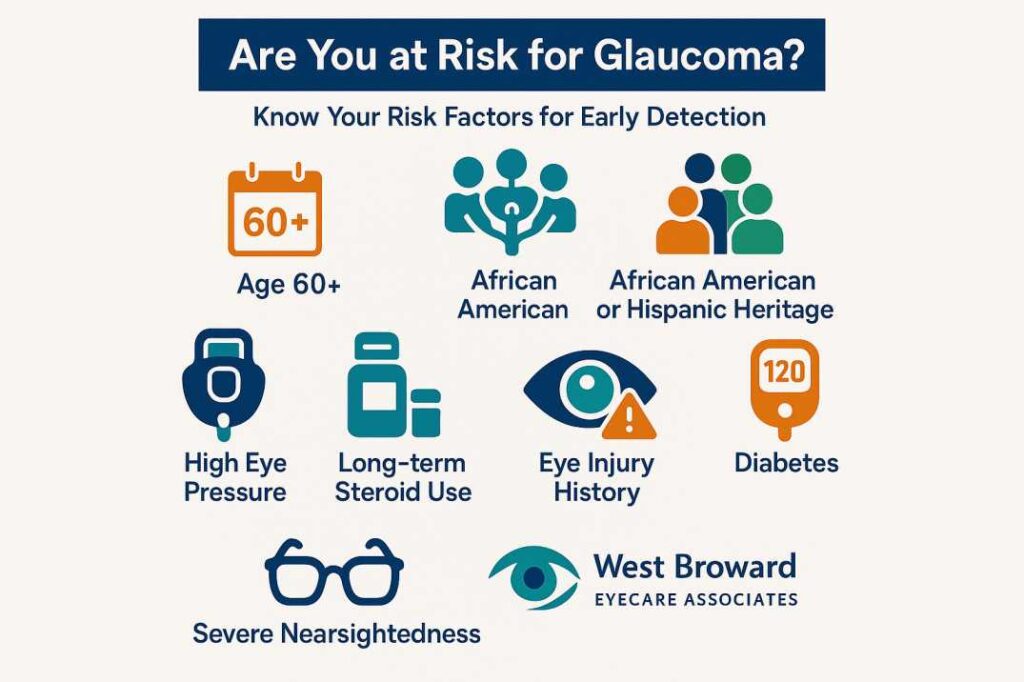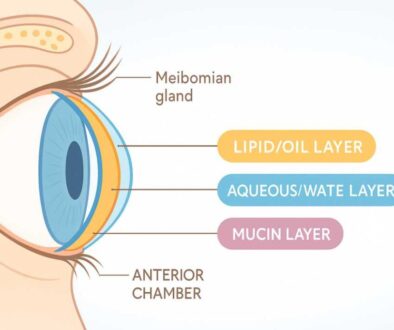Glaucoma Detection & Screening | Save Your Vision Tamarac
Bottom Line Up Front: Glaucoma, often called the “silent thief of sight,” affects approximately 4.22 million Americans, yet nearly half don’t know they have it. Regular screening is your best defense against irreversible vision loss. With early detection through routine eye exams, most people diagnosed with glaucoma will never go blind. At West Broward Eyecare Associates, we combine cutting-edge diagnostic technology with compassionate care to protect your vision for life.
Understanding Glaucoma: The Silent Vision Thief
Glaucoma screening is your first line of defense against permanent vision loss. Imagine losing your ability to see your grandchildren’s faces, read your favorite books, or drive safely—all without any warning signs. This is the reality for millions affected by glaucoma, a group of eye diseases that damage the optic nerve and can lead to permanent blindness.
The truly concerning aspect? Research shows that nearly half of people with glaucoma remain unaware they have the condition until significant vision damage has already occurred. A 2024 study published in JAMA Ophthalmology found that approximately 4.22 million people in the United States are living with glaucoma as of 2022, yet millions have not been diagnosed. This is why eye health professionals often call it the “silent thief of sight”—the disease progresses gradually and painlessly, often without noticeable symptoms until advanced stages.
What Makes Glaucoma So Dangerous?
Your optic nerve acts like a high-speed cable connecting your eyes to your brain, containing over one million nerve fibers that transmit visual information. When glaucoma damages these fibers, the loss is permanent and irreversible. Unlike many eye conditions, vision lost to glaucoma cannot be restored through surgery, medication, or any current treatment.
The disease typically develops when fluid pressure inside the eye (intraocular pressure or IOP) becomes excessive, though interestingly, up to 40% of glaucoma patients don’t have elevated eye pressure. This makes professional screening even more critical—you can’t diagnose glaucoma simply by how your eyes feel.
Why Regular Screening Is Your Vision’s Best Protection
The Early Detection Advantage
Think of glaucoma screening like a smoke detector in your home. You don’t wait until you see flames to check if it’s working—you test it regularly because early warning saves everything. The same principle applies to your vision with comprehensive glaucoma detection.
Regular eye examinations allow eye care professionals to detect glaucoma before you experience any symptoms. Studies consistently demonstrate that early intervention can slow or even stop disease progression, preserving your sight for decades to come. Recent data from major clinical trials shows that patients who receive early treatment can reduce their risk of significant vision loss by more than 50%.
Who Should Get Screened?
The American Academy of Ophthalmology recommends comprehensive eye examinations beginning at age 40 for adults without risk factors. For those at higher risk, screenings should begin earlier and occur more frequently:
General Population Guidelines:
- Under age 40 with no risk factors: Every 5-10 years
- Ages 40-54: Every 2-4 years
- Ages 55-64: Every 1-3 years
- Ages 65 and older: Every 1-2 years
However, certain risk factors warrant earlier and more frequent screening:
- Family history of glaucoma – Your risk increases nine times if a parent or sibling has the disease. If glaucoma runs in your family, inform your Tamarac eye doctor immediately for earlier screening recommendations.
- African American or Hispanic heritage – These populations face significantly higher glaucoma rates, with African Americans experiencing approximately 10% prevalence by age 70. In Tamarac’s diverse community, understanding your ethnic risk factors is crucial.
- Diabetes or high blood pressure – Systemic conditions that affect blood flow increase risk. Regular glaucoma screening is especially important if you’re managing these conditions.
- Previous eye injuries or surgeries – Physical trauma can trigger secondary glaucoma. Always mention your complete eye history during your comprehensive eye examination.
- Long-term steroid medication use – Certain medications elevate eye pressure over time
- High myopia (nearsightedness) – Severe nearsightedness correlates with increased glaucoma risk
What Happens During a Glaucoma Screening
Many patients worry that glaucoma testing will be uncomfortable or time-consuming. The reality is quite different—modern screening is quick, painless, and non-invasive.
Comprehensive Glaucoma Testing Includes:
Tonometry (Eye Pressure Measurement) Your eye doctor measures the pressure inside your eye using specialized instruments. Elevated pressure serves as a significant risk indicator, though normal pressure doesn’t guarantee you’re glaucoma-free.
Ophthalmoscopy (Optic Nerve Examination)
After dilating your pupils with eye drops, your doctor examines the optic nerve’s shape, color, and structure. This visual inspection reveals early damage before vision loss begins.
Visual Field Testing (Perimetry) This interactive test maps your complete field of vision, detecting blind spots that indicate optic nerve damage. You’ll look straight ahead and press a button whenever you see a light flash in your peripheral vision.
Optical Coherence Tomography (OCT). This cutting-edge imaging technology creates detailed cross-sectional pictures of your optic nerve and retinal nerve fiber layer. OCT can detect structural changes before functional vision loss occurs, enabling the earliest possible intervention.
Gonioscopy (Drainage Angle Examination) Using a special contact lens, your doctor examines the angle where your iris meets your cornea to determine if fluid drainage is blocked—a key factor in certain glaucoma types.
Pachymetry (Corneal Thickness Measurement). Since corneal thickness influences pressure readings and represents an independent risk factor, measuring this helps your doctor accurately assess your glaucoma risk.
Most patients complete all these tests in a single appointment lasting about 30-45 minutes. At West Broward Eyecare Associates in Tamarac, we explain each test thoroughly, ensuring you feel comfortable and informed throughout the process.
The Latest Breakthroughs in Glaucoma Detection and Treatment
Artificial Intelligence Revolution
Recent advances in 2024-2025 have transformed glaucoma care. Artificial intelligence algorithms now analyze diagnostic images with accuracy matching or exceeding human specialists. These AI tools can detect subtle changes in optic nerve appearance that might escape the human eye, enabling diagnosis at even earlier stages.
Machine learning models currently under development will soon predict which patients are most likely to experience rapid disease progression, allowing doctors to personalize treatment intensity from the start.
Gene Therapy and Neuroprotection
Groundbreaking research at Trinity College Dublin has developed gene therapy targeting matrix metalloproteinase-3 (MMP-3), an enzyme involved in optic nerve damage. This innovative approach aims not just to lower eye pressure, but actually to protect and potentially regenerate damaged optic nerve cells.
Additionally, researchers are investigating neuroprotective agents, including:
- Nicotinamide (Vitamin B3) – May protect retinal cells from damage
- Coenzyme Q10 and Citicoline combinations – Show promise in preserving optic nerve function
- Novel IOP-lowering medications – The FDA recently approved Omlonti (omidenepag isopropyl), which works through unique pharmacological mechanisms
Advanced Treatment Options
Selective Laser Trabeculoplasty (SLT)
Recent evidence from the landmark LiGHT trial demonstrates that laser treatment may actually surpass eye drops as first-line therapy. Patients treated with SLT experienced slower visual field progression and required fewer additional treatments compared to those starting with medication.
Minimally Invasive Glaucoma Surgery (MIGS)
Modern surgical techniques now offer effective pressure reduction with minimal risk and quick recovery. Many of these procedures can be performed alongside cataract surgery, addressing multiple vision issues simultaneously.
Smart Drainage Devices
The latest generation of glaucoma drainage implants utilizes advanced materials that resist blockage and provide longer-lasting pressure control.
Recent Research Supporting Regular Screening
Study 1: Updated U.S. Glaucoma Prevalence (2024)
A comprehensive meta-analysis published in JAMA Ophthalmology in October 2024 examined glaucoma prevalence across the United States using data from multiple sources, including the National Health and Nutrition Examination Survey, Medicare claims, and population-based studies. The research found that as of 2022, approximately 4.22 million Americans have glaucoma—1.62% of adults 18 and older, and 2.56% of those 40 and older. Additionally, 1.49 million people have vision-affecting glaucoma. The study revealed substantial variations across demographic groups, with Black individuals disproportionately affected at rates three times higher than white individuals for vision-affecting glaucoma.
Key Takeaway: These updated prevalence estimates are slightly higher than previous studies from 2016, emphasizing the growing need for expanded screening programs as the population ages.
Source: Ehrlich JR, et al. “Prevalence of Glaucoma Among US Adults in 2022,” JAMA Ophthalmology, October 2024
Study 2: AI-Enhanced Early Detection (2024)
A comprehensive review published in October 2024 analyzed machine learning applications in glaucoma management across 3,581 studies. Researchers found that deep learning algorithms can detect glaucomatous damage from OCT images with sensitivity ranging from 83% to 96% and specificity from 80% to 92%. These AI tools show particular promise for large-scale community screening programs, especially in underserved areas with limited access to eye care specialists.
Key Takeaway: Advanced technology is making high-quality glaucoma screening more accessible than ever, particularly benefiting populations at the highest risk.
Source: Artificial Intelligence and Advanced Technology in Glaucoma: A Review, PMC, October 2024
Study 3: Global Glaucoma Incidence Analysis (2024)
A systematic review and meta-analysis published in May 2024 examined prospective studies from 1990-2022, identifying six critical risk factors for primary open-angle glaucoma: advanced age, male gender, high IOP, family history, and myopia. The research emphasizes that with life expectancy increasing worldwide, the glaucoma disease burden will grow substantially, making early screening programs more critical than ever.
Key Takeaway: Population aging means more people will develop glaucoma, reinforcing the importance of screening programs that reach older adults before irreversible damage occurs.
Source: Global Incidence and Risk Factors for Glaucoma: A Systematic Review, Journal of Global Health, May 2024
Common Patient Questions and Concerns
“I See Fine—Do I Really Need Screening?”
This is perhaps the most dangerous misconception about glaucoma. The disease typically affects peripheral vision first, and your brain is remarkably good at compensating for gradual vision loss. Most patients don’t notice symptoms until they’ve already lost 40% or more of their optic nerve function.
Think of it this way: you wouldn’t skip blood pressure checks just because you feel healthy. Glaucoma screening works the same way—detecting problems before you notice symptoms gives you the best chance to preserve your vision.
“Is Glaucoma Testing Painful?”
No. All standard glaucoma tests are painless and non-invasive. The “puff of air” test (air-puff tonometry) might startle you, but it doesn’t hurt. Dilating drops may temporarily blur your vision and increase light sensitivity, but these effects wear off within a few hours.
“If I Have Glaucoma, Will I Go Blind?”
Not necessarily—and this is crucial to understand. With proper treatment and regular monitoring, most people diagnosed with glaucoma will never experience severe vision loss or blindness. The key is catching the disease early through screening and consistently following your treatment plan.
A study tracking newly diagnosed glaucoma patients over 20 years found that 27% became blind in one eye and 9% in both eyes. However, these statistics include many patients diagnosed at advanced stages. Early detection dramatically improves these outcomes.
“How Much Do Screening Tests Cost?”
Many insurance plans, including Medicare, cover annual glaucoma screenings for at-risk individuals. Medicare specifically covers yearly screenings for people with diabetes, family history of glaucoma, African Americans age 50 and older, and Hispanics age 60 and older.
At West Broward Eyecare Associates in Tamarac, we accept most insurance plans and offer flexible payment options. Our team can help you understand your coverage before your appointment. Contact us for specific pricing information.
Taking Action: Your Next Steps
Schedule Your Comprehensive Eye Exam
Don’t wait until you notice vision problems. If you’re over 40, have risk factors, or haven’t had an eye exam in over a year, contact West Broward Eyecare Associates today to schedule your comprehensive evaluation, including glaucoma screening, at our Tamarac office.
Know Your Family History
Talk to your parents, siblings, and extended family about eye health. If relatives have glaucoma, inform your eye doctor—this information significantly influences your screening schedule.
Maintain Overall Health
Your eye health connects directly to your general well-being. Follow a heart-healthy diet, exercise regularly, get adequate sleep, and manage conditions like diabetes and high blood pressure. These lifestyle factors support blood flow to your optic nerves and may slow glaucoma progression.
Educate Your Loved Ones
Share what you’ve learned about glaucoma screening with family and friends in the Tamarac community, especially those in high-risk groups. Your conversation might be the nudge someone needs to schedule that long-overdue eye exam—potentially saving their sight.
Why Choose West Broward Eyecare Associates for Glaucoma Screening
Our practice combines cutting-edge diagnostic technology with the personalized attention your family deserves. As your neighbors and your vision guardians in Tamarac, we understand that protecting your sight means protecting your independence, your safety, and your quality of life.
Our Commitment to You:
State-of-the-Art Technology: We invest in the latest diagnostic equipment, including advanced OCT imaging and computerized visual field testing, ensuring the earliest possible glaucoma detection.
Comprehensive Family Care: From your child’s first eye exam to managing complex age-related conditions, we provide expert eye care for every stage of life in Tamarac and West Broward County.
Convenient Scheduling: We offer flexible appointment times to accommodate your busy life, including options for working families in the Tamarac area.
Insurance Accessibility: We accept most major insurance plans, including Medicare and Medicaid, and provide transparent cost discussions upfront.
Ongoing Education: We take time to explain your test results in terms you can understand, empowering you to make informed decisions about your eye health.
Community Trust: As an established Tamarac practice, we’ve built lasting relationships spanning generations of families in West Broward County.
References and Resources
This article is based on the latest peer-reviewed research and authoritative medical sources. For additional information about glaucoma screening and detection, we recommend these trusted resources:
Key Scientific Studies and Medical Resources:
-
Ehrlich JR, Burke-Conte Z, Wittenborn JS, et al. “Prevalence of Glaucoma Among US Adults in 2022.” JAMA Ophthalmology, Published online October 17, 2024.
https://jamanetwork.com/journals/jamaophthalmology/fullarticle/2824384
This landmark study provides the most current U.S. glaucoma prevalence data, finding that 4.22 million Americans are living with glaucoma as of 2022. -
Glaucoma Research Foundation. “The Importance of Regular Eye Exams to Detect Glaucoma.” Updated February 11, 2025.
https://glaucoma.org/articles/the-importance-of-regular-eye-exams-to-detect-glaucoma
Comprehensive resource on glaucoma screening recommendations, testing procedures, and the critical importance of early detection. -
Centers for Disease Control and Prevention (CDC). “Vision and Eye Health Surveillance System (VEHSS): Prevalence of Glaucoma.” Updated July 28, 2025.
https://www.cdc.gov/vision-health-data/prevalence-estimates/prevalence-estimates-glaucoma.html
Official CDC data on glaucoma prevalence estimates at national, state, and county levels, including demographic breakdowns and vision-affecting glaucoma statistics.
Additional Authoritative Sources:
-
American Academy of Ophthalmology (AAO) – Comprehensive Adult Medical Eye Evaluation guidelines and glaucoma screening recommendations: www.aao.org
-
National Eye Institute (NEI) – Glaucoma information and research updates: www.nei.nih.gov
-
Yale Medicine – Patient-friendly glaucoma detection information: www.yalemedicine.org/news/glaucoma-detection-starts-with-eye-exams
The Bottom Line: Don’t Wait Until It’s Too Late
Glaucoma screening is the second-best defense against irreversible blindness in the United States, with early detection being the first. Yet this preventable cause of vision loss continues to affect millions who don’t realize they’re at risk. Regular glaucoma screening in Tamarac transforms this silent thief into a manageable chronic condition.
Every day you delay screening is another day of potential silent damage to your optic nerve. But here’s the encouraging news: scheduling your comprehensive eye exam takes just minutes, testing is painless, and early detection gives you the best possible chance of maintaining clear vision for life.
Your vision is precious—it enables you to see your loved ones’ smiles, navigate the world safely, and maintain your independence. Protect it through regular glaucoma screening starting today.
Ready to take the next step? Contact West Broward Eyecare Associates to schedule your comprehensive eye examination at our Tamarac location. Let us help you protect your vision and preserve the gift of sight for years to come.
This article was written to educate patients about the importance of glaucoma screening and early detection. Information is current as of October 2025 and reflects the latest clinical guidelines and research. Always consult with your eye care professional for personalized medical advice regarding your specific situation.
West Broward Eyecare Associates is your trusted partner in comprehensive eye health, providing expert care that enables clear vision and enhances quality of life for patients of all ages.
FAQs
-
-
It’s a painless eye test to check pressure, optic nerve health, and vision loss—vital because glaucoma often has no symptoms until vision is damaged.
-





